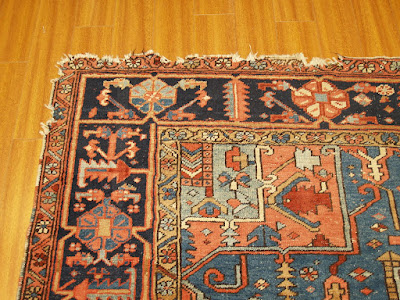








We received a severely damaged hand knotted Persian Heriz rug for cleaning and repair. Here I am posting some information in general on Heriz carpets with few pictures of this particular rug from before and after the cleaning and repair.
Heriz Carpets and Rugs
Heriz rugs are made in the weaving district of Heriz, which is made up of around 30 weaving villages. The names of the villages in this region, which is about 40 miles west of Tabriz, in north west Iran are commonly found as names of different rug styles from the area. Contrary to most carpets, these Persian hand knotted carpets are not named for the town they were created in, but for their level of quality. For example a Heriz carpet is the highest quality floor covering from the region, and then there is the Mehriban, the Gorevan, the Ahar, and the Sharabian rugs amongst many others. The Heriz carpets are all very similar in design, with a common geometric pattern.
Heriz rugs almost always have a large central medallion design and corner spandrels. The rug’s central medallion typically lies on a red field and includes geometric shapes of leaves, flowers and other motives. The rug also features a broad main border pattern that is called a Herati pattern. These floor coverings have been known to be quite large in size, normally 6 x 9 feet being the smallest size.
Heriz rugs are commonly made with a cotton warp that can be either depressed or non-depressed. The weft can have two shoots or even a single weft. The weft is normally made with cotton and is a blue color. The pile is almost always wool and are generally more coarsely woven than traditional Persian carpets. The coarse pile can cause the floor covering to wear more quickly, but a very high quality Heriz will withstand wear for much longer than a lower quality one. There are some antique pre 1900 silk pile Heriz rugs with high count knots, but these pieces are very rare.
Older Heriz rugs are typically made with softer colors, like light blue, khaki, pink, ivory and rust. Newer carpets, which are identified as post-World War II rugs, have much brighter tones like blue, green, red, white and brown. The term Serapi has been known to identify older, pre-World War II Heriz carpets. There is no village named Serapi, but it signifies a very old carpet that is very high in quality. These pieces typically have a depressed warp, the softer tones and large geometric designs. They do stay very true to the typical Heriz pattern, with a large central medallion, corner spandrels and geometric shapes.
Dr. Khosrow Sobhe (Dr. Kay)
Certified Rug Specialist (CRS)
www.LosAngelesRugCleaning.com
310-770-9085

4 comments:
Thank you very much for your very interesting and informative post. I just came across your website and enjoyed reading your posts. I would be very glad to be accepted as a follower on your site.
The best way to keep a rug clean is to keep it from getting dirty in the first place. Removing outdoor shoes when entering the house (as people do in most rug-weaving countries) is a good idea if this accords with your lifestyle.
Rug Cleaning
Those all look like very expensive and quality rugs. Compliments. Take good car of them.
cool carpets
Post a Comment